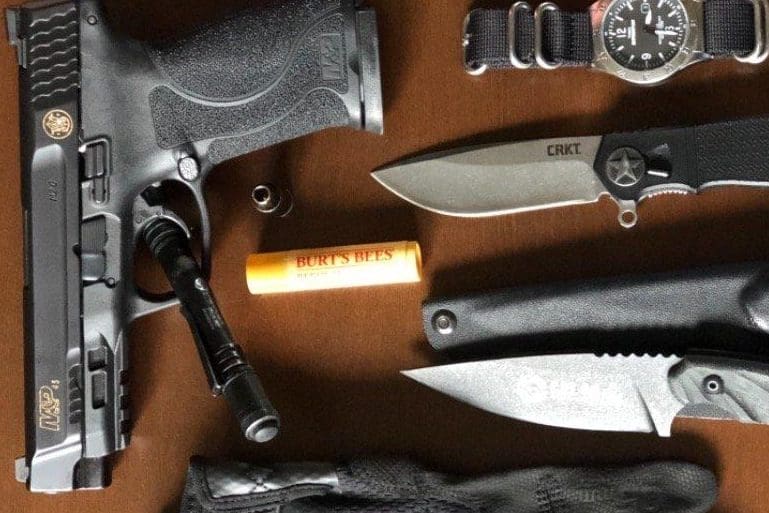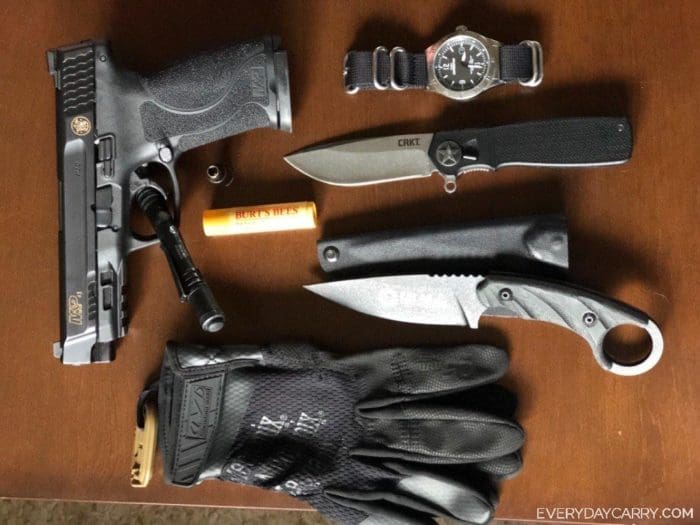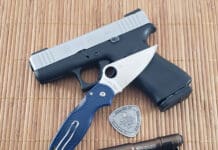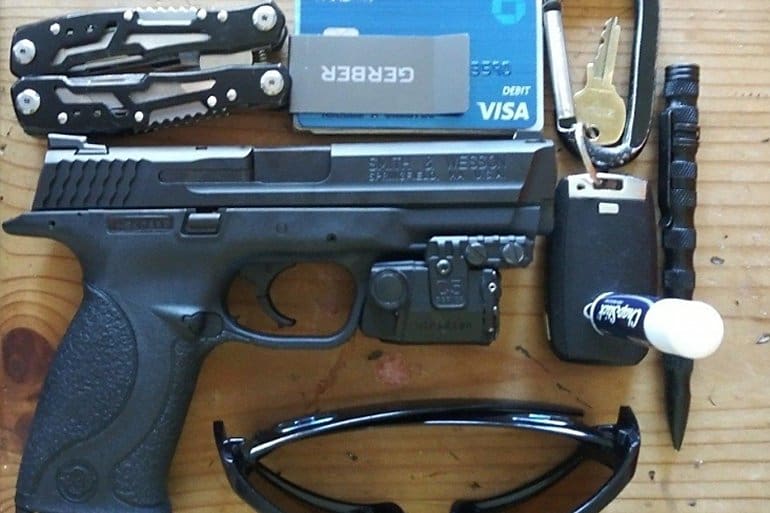This EDC is a Smith & Wesson M&P 2.0 chambered in .45 ACP as well as a couple folding knives. Although 9mm has become the frontrunner for various alphabet agencies and civilians there are still gun owners who choose to carry guns chambered in other cartridges. This time it’s .45 ACP (side note: I own this gun myself).
Before you let the “soul-stealing” jokes fly, remember that .45 ACP has its merits. Like it or not, bigger holes allow for faster loss of vital body fluids (but yes, placement is always king…this could — and may — become a massively long discussion).
If you’re going to carry a .45 ACP take care with ammunition selection. Of course, you should always choose carefully, but I mention this specifically with .45 ACP because not all ammunition is created equally and you want a load capable of greater velocity, expansion, and weight retention than most.
A truly slow round with poor penetration is the last thing you want on your hip. Federal HST 230 grain JHPs have a muzzle velocity of 890 feet per second and muzzle energy of 404 foot-pounds and average penetration depth of 14 inches. If you prefer a lighter bullet check out Remington Golden Saber 185 grain HPJs (High Performance Jacket) which has a muzzle velocity of 1015 feet per second and muzzle energy of 423 foot-pounds.
Remember, your 9mm/.380 ACP/10mm/whatever won’t do you any good if you cannot aim well under stress. So whatever you carry, train.







Winchester Kinetic HE, 185 grain, 1,110 FPS out of the muzzle, 506 ft lbs. That’s the round I use in my Glock 21.
But as was pointed out in another recent article, the .45 does not ‘pulverize’ bone and flesh like the 5.56 round or whatever was being castigated by a ‘professional’ writer on why bullets are bad. No. The .45 massages and caresses the bone and flesh, as it’s a slower shell. Much better for the recipient.
The Great Prophet, John Moses Browning, proved to all mankind that a 0.45in hole in an assailant’s body is the optimal diameter to allow freedom and justice to enter their bodies.
Actually, the .45acp was developed per the Army’s request for a modern auto pistol that matched the ballistics of the M1887 Military Ball Cartridge used in the Colt Single Action Army and S&W Schofield revolvers. The affect of .45 caliber bullets on bad guys was well known before Browning ever designed a pistol.
The 1911 started life as the Colt Model of 1902. In .38 ACP. The army demanded a .45 bore, and suggested that a round with about the same velocity as a .45 colt revolver would suit them nicely. So Browning delivered what the customer wanted, just as every successful businessman must.
Why settle for a .45 hole nowadays? HST will deliver .75in holes from a 9mm and .90 holes from a .45acp.
Before you let the “soul-stealing” jokes fly, remember that .45 ACP has its merits.
Hm. So what happens if you shoot a ginger with .45 ACP?
The ginger bursts into flame, the shooter falls over with a horrible sunburn to their soul and and the .45 disappears into a black hole.
Forgive my ignorance, what is weight retention?
Weight retention is how much weight the projectile retains inside the target. Often, a projectile will fragment or lose part of its jacket if it is poorly designed or fired out of spec. It is typically better if the projectile stays in one piece, I guess.
Only for penetration. If one wants to impart maximum shock for targets that are light and/or small compared to the caliber, one wants frangible rounds, which are designed to break apart and retain little of their original weight. This makes for spectacular results on something small and fragile, but will only make a nasty surface hole in whatever the target was, which, since it won’t reach the vitals, will probably only make s/he/it really, really angry.
For big, dangerous targets penetration(and weight retention) are the things to shoot for. The king of weight retention is a simple, cast lead slug, usually retaining 95+% of their weight after impact. Must be a cast slug though. Most purchased, plain lead bullets are swaged, which requires pure, very soft, lead to manufacture.
Casting is labor intensive, and so is not well suited to mass manufacture. Casting, on the other hand, is perfect for DIY, and the tin or antimony added to the lead alloy makes them both cast better, and perform better.
No need to apologize for a great question!
Bullet weight retention is the actual weight (usually stated in grains) that is retained after stricking a target and coming to a point of rest. Usually, you will also see it expressed as a percentage of retained weight (150 of 200 original grains of weight – 75% weight retention).
Bullets loose weight as they go through objects and tiny pieces break off. This is especially true with windshields and other hard object. This is also the reason for bonded rounds, such as the Speer Gold Dot. The idea is to prevent jacket-core separation. No round will retain 100% if its weight when going through an object, but the more retained weight, the more mass that is actually making it to the vital organs.
I hope this helps!
Great answer Jeff.
Big or small, they all fall to hardball. Plan for the unexpected Rounds in the magazine can be mixed; HP, HP, HP, FMJ, HP,HP… use a tracer for the penultimate round and always know when you’re about to empty out. Carry one magazine full of tracers in case you want everyone to shoot the same target at the same time or you need to start a fire and roast marshmallows. Always try to be creative. Nothing says all the ammo in a magazine has to be the same. At intermediate ranges the bullet holes might spread out a little, but more bullets (within reason) in the target is a good thing.-30-
A mag full of tracers in a carry gun would be goddamn funny.
You need to shout “I’M A’ FIRIN’ MAH LAZER!” to get the full effect.
Too bad that the tracer compound is in the rear of the projectile where only the firer(or at least behind the bullet) can see it, huh?
Not my trick, I learned it from a Kiwi, Vietnam veteran I worked with years ago. If it sounds stupid, but works, it’s not stupid. Never had to use it, he trained us all with it. He taught us some other unpleasant stuff. Tracers are still bullets, they still make the target aware of the error of their ways. Never had to use it, always wanted to. -30-
Refer to Lucky Gunner’s tests – handgun defensive ammo ballistic tests. Federal HST is top notch in almost every caliber offered. HOWEVER, there are others that are quite good. Look at this article. The results are VERY revealing.
For a dissenting viewpoint check out Paul Harrell and his meat test’s. No gel but mimicking real world gunshot wounds. Meh on HST. Actually better with Sig Vcrown…
I am surprised that there aren’t more comments to this article. I am seriously considering a switch to 45 for EDC. Why? My ability to deliver fast and accurate shots with my 45 XDm compact is very, very close to what I can do with my Glock 19. A pistol is basically a long distance punch press so I figure the bigger the hole, the better. You do give up 30% of capacity though. Primary + backup = 21 rounds in the XDm versus 30 in the Glock 19. (Ammo cost isn’t really a big issue for me).
Maybe a test comparing Underwood/Lehigh/Black Hills and their new wonder slugs out of a .45 would be worthwhile.
The Lord’s Caliber, and two knives, without any tourniquets or flashlights to bog him down in a fight. He’ll yea borther.
Under penetration has never been a problem with hardball or softball(slower) 45 acp.
Getting it to stop inside the body has proven difficult.
But it still poke a hole.
I just can’t do plastic guns. I used to be big on muzzle energy’s until actual field use proved to me it’s not accurate. As far as I’m concerned the .45 acp is the king daddy of the defense pistol cartridge’s.
But, the .45 damages the ozone layer when you fire it. Just be careful and use only when necessary.
When you shoot a .45 it takes out the bad guy you’re aiming at, plus at least one other random evildoer somewhere else on planet earth. True story.
What are the penetration and expansion for the Golden Saber? Adequate penetration is critical. Expansion is a nice bonus. I think of .45, even if it doesn’t expand, as a pre-expanded .38 or 9 mm. (Round nose isn’t so good because it parts the tissue instead of tearing it.)
.45 ACP ball is the base line. There are many modern bullet coatings originally developed to make 9MM HP more effective. They work most of the time. Applying any of these coatings to the .45 HP bullets won’t make it any smaller. Sometimes .45 ball punches a straight line, sometimes it doesn’t. Either way you just put one or two respectable holes in the target. That’s why I said mix the ammo in the magazines. Besides, the whole point of the exercise is to get to the old Ithaca M37, Win. M97 or M12. Fire the first shot, hold the trigger to the rear and reciprocate the slide until the shotgun’s empty. Reload and repeat as necessary. Good times. -30-
Where caliber wars are most relevant is in the class of micro compact guns. The merits of increased capacity and controllability in 9mm are much more significant. The 8-10 round capacity in 9mm vs ~6 round capacity of .45 is more likely to be relevant when comparing compact carry guns. With full size guns they are all pretty controllable right off the bat and 17 vs 13 round capacity is less of an issue.
My EDC is my house and barn keys and a G19. If I’m going out in town, my card holder, ankle bracelet(cellphone), and maybe a cheap ballpoint pen if its someplace nice. Yeah, I don’t even use a full size wallet.
Unless someone has a dangerous or exotic job, I highly doubt these EDC tacticool pictures are legit. They are feeling more and more like advertisements and brand name exposure.
The M&P45 carries very well. While some are put off by the 10 round capacity, it is the same thickness as a Glock 17. I have both the M&P45 and a Glock 21 and the difference between the two is obvious. One is set up as a standard frame handgun, while one is clearly a large frame.
The ergonomics are great, regardless of the shooters stature/hand size. Yes there is more recoil than the Glock 21, but this is due to the weight.
It’s like having a Glock in 45 Gap without the thicker slide/oddball caliber. It’s a full-size 45 that carries like a 9mm.
However I don’t carry either much anymore after falling in love with my Shield 45.
I let this go on for too long; insert sarcastic comment comparing.45 ACP and 6.5 here.
E.g. .45, because a 6.5 auto loading pistol hasn’t been made yet.
All you need with the Creedmoor is one shot. Pistol doesn’t need a magazine or cylinder.
A brace of snub nosed Contendors and you’re ready for SHTF.
Sold all but one of my plastic fantastic wunder 9’s. EDC on body and off body are now 45’s. Wish Smith would make a 45 Bodyguard. DAO has it’s place.
I have a XDM .45 Love the way it shoots but it is a little heavy for EDC. My choice is my FN-FiveSeven 20 rds in mag weighs less loaded than my xd empty. Also velocity of 1850 fps so does about the same damage as an AR rifle! I have shot mine a ton and the LE Green tips will penetrate up to level 2 body armor. Don’t get me wrong I still love my .45 APC just my 2 cents worth on edc!
Comments are closed.